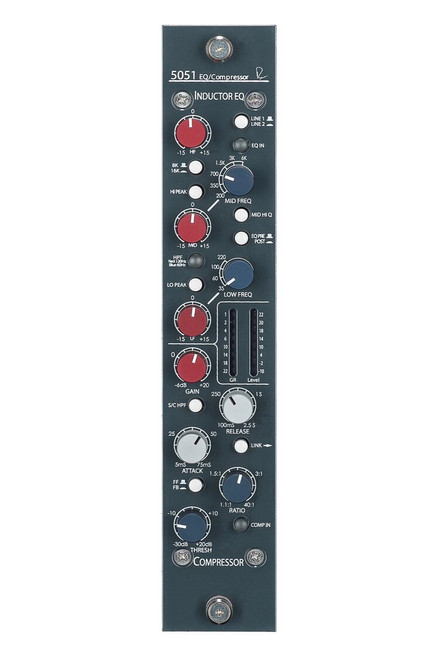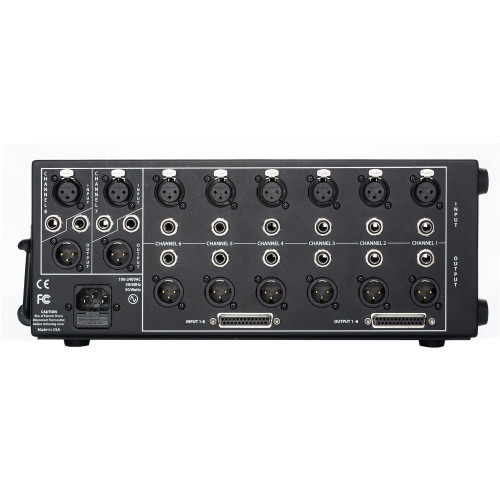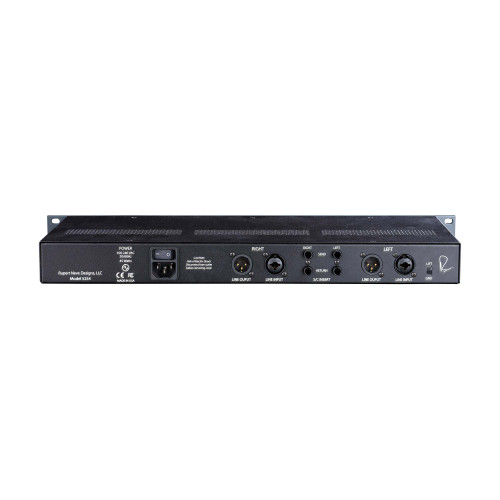Classic tone & dynamics control for the 5088.
The 5051 combines a three-band Inductor EQ based on Rupert’s vintage designs with the power & flexibility of the Portico II Compressor. Utilizing a fully-discrete class-A signal path and custom audio transformers and inductors, the 5051 delivers all the performance and musicality expected from a Rupert Neve design.
What is an Inductor Equalizer?
Inductors are wires wound around a coil that provide a form of frequency-dependant resistance. When they saturate, they bring out beautifully musical harmonics that give your tracks the smooth, polished sound that has made Rupert’s consoles and equipment so desirable for over fifty years. This is what makes them different from capacitor-based EQ designs, which do a great job at surgical equalization. But inductors provide the tone.
While it is certainly possible to create a functioning EQ using off-the-shelf inductors, we choose to use our own custom inductors for the 5051. This attention to detail in controlling variables such as the winding and core materials in relation to the surrounding circuitry allows the 5051 to capture the vitality and personality of Rupert’s classic designs.
The “Best-Of” EQ
The 5051’s 3-band, custom-tapped inductor EQ was inspired by our favorite elements of Rupert’s vintage EQ designs. The low frequency band is designed to produce a creamy, resonant bass response similar to a vintage 1064 – but unlike the vintage modules, the LF band on the 5051 can be used as either a shelf or a peak filter, adding punch, dimension, and control to your low end.
The midrange band is based on that of the 1073, ideal for sweetening vocals and instruments while bringing them forward in a mix, and its proportional “Q” response makes it well-suited for minimizing problematic frequencies. The high frequency band is a hybrid vintage / modern design, blending inductor circuitry with capacitor-based topologies to achieve vintage tones with enhanced control. The High Pass filter is an 18dB/octave design with a switchable 60Hz or 120Hz corner frequency, and can be used in tandem with the low frequency EQ to add low-end presence without clouding the source material.
As with Rupert’s most prized classic designs, each EQ section uses low-feedback, class-A discrete electronics to prevent low-level artifacts and harshness from detracting from the tonal shaping. However, this new circuit is a decidedly modern design with updated techniques and components that were simply not available 50 years ago, and is definitely not a “clone”.
The VCA Compressor
Every compressor has a gain control element in its circuit, and this is generally what determines the “sound” of the compressor. Some compressors use tubes, some use FETs, some use light-dependent resistors, some use a diode bridge – but in the 5051, a VCA (Voltage Controlled Amplifier / Attenuator) is used to control the signal’s gain.
In contrast to a diode bridge design like our 5254, which adds a thick, colorful tonality to the source, the 5051 makes use of a very accurate, low noise, low distortion VCA with essentially no sonic signature of its own. This provides an immense amount of dynamic control without leaving a heavy sonic imprint on your tracks or mixes – perfect for control across an entire console’s worth of channels.
Feed-Forward vs. Feed-Back
This switch changes the point in the signal path where the VCA control voltage is picked off: either before the VCA (feed-forward) or after the VCA (feed-back). In most of Mr. Neve’s earliest designs, feed-back detection was intrinsic to the musical dynamic response. However, the very nature of a feedback compressor limits the attack time of the compression circuit, as the control voltage has already passed through the VCA itself. To offer faster, more technically accurate response times, feed-forward detection was also implemented in the 5051: with the FF / FB switch, both classic and modern VCA responses are available.
RMS vs. Peak
One of the more unique features of our VCA compressors is the Peak / RMS mode. This switch allows the VCA to respond to both RMS (Root Mean Square) and peak levels. RMS circuits are considered to better mimic the way the ears perceive apparent loudness, while peak circuits tend to directly respond to the waveform voltage, which may be more of a concern for prevention of clipping and maximizing levels. In this case, peak mode uses a combination of both methods to get the best of both worlds, and avoids the drawbacks of each method on its own.
POWER & RACKS
The 5051 receives +/- 24V rails from an external DC power supply using a 4-pin connection. There are currently two options available: a 25-way 2U rack-mount supply, or a smaller 5-way “brick” supply.
The 5051 can be mounted in our vertical 2–way wooden racks, 9-way metal racks, or within a 5088’s penthouse section.













